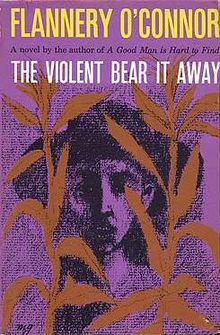 Francis Marion Tarwater, a fourteen-year-old hillbilly, is the main protagonist of O’Connor’s second novel (published in 1960). The drama concerns his struggle to free himself from the polar-opposite influences of two adults. The first influence is that of his great uncle; an old backwoods prophet named Mason who raised the orphaned Tarwater to follow in his footsteps. Mason is dead and buried at the start of the first chapter, but his living presence is recalled and felt off and on throughout the novel. The second influence is that of another uncle; a schoolteacher named Rayber who wants to free Tarwater from the old man: “I can help correct what he’s done to you, help you to correct it yourself.” And poised vulnerably in the midst of all this is a true innocent—a child named Bishop whose mental disability is not specified though it might be a case of Down syndrome. Mason had tried to baptize this child but was impeded by Rayber, the child’s father. “If by the time I die,” [Mason] had said to Tarwater, “I haven’t got him baptized, it’ll be up to you. It’ll be the first mission the Lord sends you.” Thus the novel’s plot and central conflict is established.
Francis Marion Tarwater, a fourteen-year-old hillbilly, is the main protagonist of O’Connor’s second novel (published in 1960). The drama concerns his struggle to free himself from the polar-opposite influences of two adults. The first influence is that of his great uncle; an old backwoods prophet named Mason who raised the orphaned Tarwater to follow in his footsteps. Mason is dead and buried at the start of the first chapter, but his living presence is recalled and felt off and on throughout the novel. The second influence is that of another uncle; a schoolteacher named Rayber who wants to free Tarwater from the old man: “I can help correct what he’s done to you, help you to correct it yourself.” And poised vulnerably in the midst of all this is a true innocent—a child named Bishop whose mental disability is not specified though it might be a case of Down syndrome. Mason had tried to baptize this child but was impeded by Rayber, the child’s father. “If by the time I die,” [Mason] had said to Tarwater, “I haven’t got him baptized, it’ll be up to you. It’ll be the first mission the Lord sends you.” Thus the novel’s plot and central conflict is established.
On the basis of his often frenzied behavior—if not his religious convictions as such—most readers label Mason a fanatic. But if that is true of the old uncle, it must be true of the younger one as well. In his own way, Rayber is every bit as extreme as Mason. Even so, neither of the two men is caricatured by the author. Mason’s religious beliefs have been subjected to a number of severe trials; and though his zeal never wanes, he is greatly humbled as a result. Rayber is himself innately religious, in spite of his secular values; he is, at least potentially, a mystic like Francis of Assisi or Alexey Karamazov. But as a result of various pains and disappointments, he kills off each and every religious impulse that springs up within his mind or heart. His life is, ironically, an upside-down form of religious commitment.
Other important characters should be mentioned. Buford Munson, the old man’s African-American neighbor, is a stern moral presence. Another important character is Tarwater’s mysterious “friend”, who shows up shortly after the death of the great uncle. This sinister figure that keeps close to Tarwater and seems to be concerned with his welfare and happiness is actually the devil. At least that was what the author intended.
“The Violent Bear It Away” is, for me, a less successful novel than “Wise Blood”, O’Connor’s first novel. There is too much flashback, too much family history; and the conclusion, though certainly not bad, has always struck me as somewhat muddled or imprecise. The author herself had serious doubts about the worth of “The Violent Bear It Away”. Still, its strengths exceed by far its weaknesses. In fact, second only to “Wise Blood”, it is my favorite novel. It is harrowing, humorous, fierce and vivid; and the conflicts it deals with are especially relevant today.